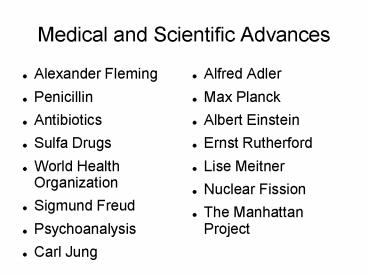Medical and Scientific Advances - PowerPoint PPT Presentation
1 / 15
Title:
Medical and Scientific Advances
Description:
Medical and Scientific Advances Alexander Fleming Penicillin Antibiotics Sulfa Drugs World Health Organization Sigmund Freud Psychoanalysis Carl Jung – PowerPoint PPT presentation
Number of Views:144
Avg rating:3.0/5.0
Title: Medical and Scientific Advances
1
Medical and Scientific Advances
- Alexander Fleming
- Penicillin
- Antibiotics
- Sulfa Drugs
- World Health Organization
- Sigmund Freud
- Psychoanalysis
- Carl Jung
- Alfred Adler
- Max Planck
- Albert Einstein
- Ernst Rutherford
- Lise Meitner
- Nuclear Fission
- The Manhattan Project
2
Alexander Fleming
- Fleming ? discovered that specific molds can kill
infectious bacteria - Penicillin ? specific mold that can be used to
kill many types of malicious bacteria - Penicillin would eventually lead a wave of
antibiotics ? treatments that could be used to
slowly rid the body of infectious bacteria
3
Sulfa Drugs
- German chemists were able to discover a red dye
(Prontosil) could be used to cure infections. - These drugs would be known as sulfanilamides ?
these would be also known as sulfa drugs ? used
to cure many infections and illnesses such as
strep throat. - These drugs have proven effective over time but
overuse can lead to adaptation by the germs which
prompts further work in the field
4
Other Advances
- Other advances were made in the medical field
that contributed to modern medicine and has
helped cure many disease. - The polio vaccine ? developed by Jonas Salk, used
to cure polio which attacks the nervous system
and slowly deteriorates the body. - The World Health Organization ? program used to
provide immunizations to areas where people
cannot afford them. - Surgical advances ? neurosurgery became common
around World War I, blood transfusions,
pacemakers and transplants
5
Sigmund Freud
- Freud ? considered the father of psychoanalysis
by many, one of the early leaders of the mental
health field. - Freud believed that people's problems were caused
by deep rooted problems that had been pushed into
the deeper parts of one's memory. - He believed talk therapy or psychoanalysis was
the only way to cure these problems. - Many people became followers of psychoanalysis.
6
Other Psychoanalysts
- Carl Jung ? believed that one's creative
expression was a means by which one could figure
out the neuroses affecting a person's life - Jung would have his patients draw or write their
dreams as a means of figuring out more about a
person and their problems - Alfred Adler ? posited the inferiority complex ?
those that had poor opinions of themselves were
more likely to engage in anti-social or
destructive behavior. - Adler believed that if one had a better
self-image, they would be able to overcome their
problems more readily.
7
Results of Medical Advances
- Many major diseases that served to be the
scourges of the past were now easily cured or
avoided. - New diseases would arrive in the future leading
to new innovation being necessary to continue
progression in medicine - Mental health advances allowed for new techniques
in dealing with criminals and other anti-social
individuals - Allowed professionals to be able to attempt
rehabilitation and prevention of negative
behavior.
8
Background to Atomic Theory
- Initially, physicists believed that atoms were
just solid balls that served as building blocks
for matter. - Upon Curie's discovery of radium, she posited
that these atoms have different weights and that
they constantly give off tiny particles of matter
called electrons and protons.
9
Max Planck
- Planck ? discovered that atoms release their
particles in uneven spurts called quanta. - His studies suggest that there is no sharp
division between matter and energy. - His field would be known as quantum mechanics.
10
Albert Einstein
- Einstein ? scientist chased out of Germany in
1933 who became a leader in atomic theory and
physics. - Challenged Newton's theory about the constancy of
time and space ? could not be fixed since
everything is in motion.
11
Theory of Relativity
- Stated that speed and distance are relative to
the frame of reference from which they are
measured. - There is only one constant, the speed of light.
- Discovered that matter and energy are in essence
the same thing. - Matter is capable of releasing large amounts of
energy (expressed in the equation E
mc(squared)).
12
Ernst Rutherford
- Rutherford ? discovered the structure of an atom
in 1911. - Described atoms as a mini solar system with
particles revolving around the nucleus. - Through his theory, he was able to split the atom
in 1917.
13
Lise Meitner
- Meitner ? helped discover nuclear fission ?
process by which a heavy nucleus is combined with
another particle and then divides into two
lighter nuclei. - Realized that if this process is done in a chain
reaction, the amount of energy released would be
immense
14
Nuclear Fission and the Manhattan Project
- Niels Bohr, a leading nuclear fission theorist,
was forced to leave Denmark for the United States
upon the invasion by the Nazis in 1940. - He would help in the creation of the atomic bomb
in Los Alamos, New Mexico. - He would be joined by Enrico Fermi, Robert
Oppenheimer and Edward Teller in the Manhattan
Project ? mission to build the atomic bomb. - Created the first nuclear reaction in 1942.
- Teller would help create the hydrogen bomb
15
Manhattan Project































